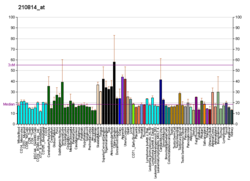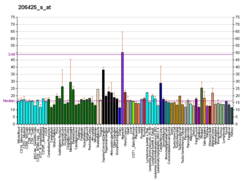Protein and coding gene in humans
| TRPC3 |
|---|
|
| Identifiers |
|---|
| Aliases | TRPC3, SCA41, TRP3, transient receptor potential cation channel subfamily C member 3 |
|---|
| External IDs | OMIM: 602345; MGI: 109526; HomoloGene: 20708; GeneCards: TRPC3; OMA:TRPC3 - orthologs |
|---|
| Gene location (Human) |
|---|
 | | Chr. | Chromosome 4 (human)[1] |
|---|
| | Band | 4q27 | Start | 121,874,481 bp[1] |
|---|
| End | 121,952,060 bp[1] |
|---|
|
| Gene location (Mouse) |
|---|
 | | Chr. | Chromosome 3 (mouse)[2] |
|---|
| | Band | 3 B|3 17.93 cM | Start | 36,674,631 bp[2] |
|---|
| End | 36,744,316 bp[2] |
|---|
|
| RNA expression pattern |
|---|
| Bgee | | Human | Mouse (ortholog) |
|---|
| Top expressed in | - secondary oocyte
- endothelial cell
- pituitary gland
- anterior pituitary
- gastric mucosa
- putamen
- ganglionic eminence
- prefrontal cortex
- stromal cell of endometrium
- caudate nucleus
|
| | Top expressed in | - cerebellar vermis
- medial dorsal nucleus
- lateral geniculate nucleus
- medial geniculate nucleus
- medial vestibular nucleus
- superior colliculus
- superior frontal gyrus
- globus pallidus
- pineal gland
- dorsal tegmental nucleus
|
| | More reference expression data |
|
|---|
| BioGPS | 
 | | More reference expression data |
|
|---|
|
| Gene ontology |
|---|
| Molecular function | - store-operated calcium channel activity
- calcium channel activity
- inositol 1,4,5 trisphosphate binding
- ion channel activity
- protein binding
| | Cellular component | - integral component of membrane
- membrane
- plasma membrane
- integral component of plasma membrane
- cation channel complex
| | Biological process | - response to ATP
- positive regulation of calcium ion transport into cytosol
- ion transport
- single fertilization
- platelet activation
- response to calcium ion
- calcium ion transmembrane transport
- positive regulation of cardiac muscle hypertrophy in response to stress
- manganese ion transport
- calcium ion transport
- phototransduction
- transmembrane transport
- regulation of cytosolic calcium ion concentration
| | Sources:Amigo / QuickGO |
|
| Orthologs |
|---|
| Species | Human | Mouse |
|---|
| Entrez | | |
|---|
| Ensembl | | |
|---|
| UniProt | | |
|---|
| RefSeq (mRNA) | |
|---|
NM_001130698
NM_003305
NM_001366479 |
| |
|---|
| RefSeq (protein) | |
|---|
NP_001124170
NP_003296
NP_001353408 |
| |
|---|
| Location (UCSC) | Chr 4: 121.87 – 121.95 Mb | Chr 3: 36.67 – 36.74 Mb |
|---|
| PubMed search | [3] | [4] |
|---|
|
| Wikidata |
| View/Edit Human | View/Edit Mouse |
|
Short transient receptor potential channel 3 (TrpC3) also known as transient receptor protein 3 (TRP-3) is a protein that in humans is encoded by the TRPC3 gene. The TRPC3/6/7 subfamily are implicated in the regulation of vascular tone, cell growth, proliferation and pathological hypertrophy.[5] These are diacylglycerol-sensitive cation channels known to regulate intracellular calcium via activation of the phospholipase C (PLC) pathway and/or by sensing Ca2+ store depletion.[6] Together, their role in calcium homeostasis has made them potential therapeutic targets for a variety of central and peripheral pathologies.[7]
Function
Non-specific cation conductance elicited by the activation of TrkB by BDNF is TRPC3-dependent in the CNS.[8] TRPC channels are almost always co-localized with mGluR1-expressing cells and likely play a role in mGluR-mediated EPSPs.[9]
The TRPC3 channel has been shown to be preferentially expressed in non-excitable cell types, such as oligodendrocytes.[6] However, evidence suggests that active TRPC3 channels in basal ganglia (BG) output neurons are responsible for maintaining a tonic inward depolarizing current that regulates resting membrane potential and promotes regular neuronal firing.[10] Conversely, inhibiting TRPC3 promotes cellular hyperpolarization, which can lead to slower and more irregular neuronal firing. While it's unclear if TRPC3 channels have equal expression, other members of the TRPC family have been localized to the axon hillock, cell body, and dendritic processes of dopamine-expressing cells.[11]
The neuromodulator, substance P, activates TRPC3/7 channels inducing cellular currents that underlie rhythmic pacemaker activity in the brainstem, enhancing the regularity and frequency of respiratory rhythms,[12] showing homology to the mechanism described in BG neurons. Transgenic cardiomyocytes expressing TRPC3 show prolonged action potential duration when exposed to a TRPC3 agonist.[13] The same cardiomyocytes also increase their firing rate with agonist exposure under a current-clamp tetanus protocol suggesting that they may play a role in cardiac arrhythmogenesis.
Modulators
A small molecule agonist is GSK1702934A and antagonists are GSK417651A and GSK2293017A.[5] A commercially available inhibitor is available in the form of a pyrazole compound, Pyr3[14] TRPC3 has been shown to specifically interact with TRPC1[15][16] and TRPC6.[17]
See also
References
- ^ a b c GRCh38: Ensembl release 89: ENSG00000138741 – Ensembl, May 2017
- ^ a b c GRCm38: Ensembl release 89: ENSMUSG00000027716 – Ensembl, May 2017
- ^ "Human PubMed Reference:". National Center for Biotechnology Information, U.S. National Library of Medicine.
- ^ "Mouse PubMed Reference:". National Center for Biotechnology Information, U.S. National Library of Medicine.
- ^ a b Xu X, Lozinskaya I, Costell M, Lin Z, Ball JA, Bernard R, Behm DJ, Marino JP, Schnackenberg CG (2013-01-29). "Characterization of Small Molecule TRPC3 and TRPC6 agonist and Antagonists". Biophysical Journal. 104 (2, Supplement 1): 454a. Bibcode:2013BpJ...104..454X. doi:10.1016/j.bpj.2012.11.2513.
- ^ a b Fusco FR, Martorana A, Giampà C, De March Z, Vacca F, Tozzi A, Longone P, Piccirilli S, Paolucci S, Sancesario G, Mercuri NB, Bernardi G (July 2004). "Cellular localization of TRPC3 channel in rat brain: preferential distribution to oligodendrocytes". Neuroscience Letters. 365 (2): 137–42. doi:10.1016/j.neulet.2004.04.070. PMID 15245795. S2CID 27636840.
- ^ Kaneko Y, Szallasi A (2013-01-01). "TRP channels as therapeutic targets". Current Topics in Medicinal Chemistry. 13 (3): 241–3. doi:10.2174/1568026611313030001. PMID 23432057.
- ^ Li HS, Xu XZ, Montell C (1999). "Activation of a TRPC3-dependent cation current through the neurotrophin BDNF". Neuron. 24 (1): 261–73. doi:10.1016/S0896-6273(00)80838-7. PMID 10677043. S2CID 16174327.
- ^ Giampà C, DeMarch Z, Patassini S, Bernardi G, Fusco FR (September 2007). "Immunohistochemical localization of TRPC6 in the rat substantia nigra". Neuroscience Letters. 424 (3): 170–4. doi:10.1016/j.neulet.2007.07.049. PMID 17723267. S2CID 43481432.
- ^ Zhou FW, Matta SG, Zhou FM (January 2008). "Constitutively active TRPC3 channels regulate basal ganglia output neurons". The Journal of Neuroscience. 28 (2): 473–82. doi:10.1523/JNEUROSCI.3978-07.2008. PMC 3652281. PMID 18184790.
- ^ Zhu MX, Huang J, Du W, Yao H, Wang Y (2011). "TRPC Channels in Neuronal Survival". In Zhu MX (ed.). TRPC Channels in Neuronal Surviva. Boca Raton (FL): CRC Press/Taylor & Francis. ISBN 978-1-4398-1860-2. PMID 22593969.
- ^ Ben-Mabrouk F, Tryba AK (April 2010). "Substance P modulation of TRPC3/7 channels improves respiratory rhythm regularity and ICAN-dependent pacemaker activity". The European Journal of Neuroscience. 31 (7): 1219–32. doi:10.1111/j.1460-9568.2010.07156.x. PMC 3036165. PMID 20345918.
- ^ Doleschal B, Primessnig U, Wölkart G, Wolf S, Schernthaner M, Lichtenegger M, Glasnov TN, Kappe CO, Mayer B, Antoons G, Heinzel F, Poteser M, Groschner K (April 2015). "TRPC3 contributes to regulation of cardiac contractility and arrhythmogenesis by dynamic interaction with NCX1". Cardiovascular Research. 106 (1): 163–73. doi:10.1093/cvr/cvv022. PMC 4362401. PMID 25631581.
- ^ Kiyonaka S, Kato K, Nishida M, Mio K, Numaga T, Sawaguchi Y, Yoshida T, Wakamori M, Mori E, Numata T, Ishii M, Takemoto H, Ojida A, Watanabe K, Uemura A, Kurose H, Morii T, Kobayashi T, Sato Y, Sato C, Hamachi I, Mori Y (March 2009). "Selective and direct inhibition of TRPC3 channels underlies biological activities of a pyrazole compound". Proceedings of the National Academy of Sciences of the United States of America. 106 (13): 5400–5. Bibcode:2009PNAS..106.5400K. doi:10.1073/pnas.0808793106. PMC 2664023. PMID 19289841.
- ^ Strübing C, Krapivinsky G, Krapivinsky L, Clapham DE (October 2003). "Formation of novel TRPC channels by complex subunit interactions in embryonic brain". The Journal of Biological Chemistry. 278 (40): 39014–9. doi:10.1074/jbc.M306705200. PMID 12857742.
- ^ Xu XZ, Li HS, Guggino WB, Montell C (June 1997). "Coassembly of TRP and TRPL produces a distinct store-operated conductance". Cell. 89 (7): 1155–64. doi:10.1016/S0092-8674(00)80302-5. PMID 9215637. S2CID 15275438.
- ^ Hofmann T, Schaefer M, Schultz G, Gudermann T (May 2002). "Subunit composition of mammalian transient receptor potential channels in living cells". Proceedings of the National Academy of Sciences of the United States of America. 99 (11): 7461–6. Bibcode:2002PNAS...99.7461H. doi:10.1073/pnas.102596199. PMC 124253. PMID 12032305.
Further reading
- Islam, Md. Shahidul (January 2011). Transient Receptor Potential Channels. Advances in Experimental Medicine and Biology. Vol. 704. Berlin: Springer. p. 700. ISBN 978-94-007-0264-6.
- Lemmon MA (March 2005). "Pleckstrin homology domains: two halves make a hole?". Cell. 120 (5): 574–6. doi:10.1016/j.cell.2005.02.023. PMID 15766521. S2CID 16696677.
- Clapham DE, Julius D, Montell C, Schultz G (2006). "International Union of Pharmacology. XLIX. Nomenclature and structure-function relationships of transient receptor potential channels". Pharmacol. Rev. 57 (4): 427–50. doi:10.1124/pr.57.4.6. PMID 16382100. S2CID 17936350.
- Eder P, Poteser M, Groschner K (2007). "TRPC3: A Multifunctional, Pore-Forming Signalling Molecule". Transient Receptor Potential (TRP) Channels. Handbook of Experimental Pharmacology. Vol. 179. pp. 77–92. doi:10.1007/978-3-540-34891-7_4. ISBN 978-3-540-34889-4. PMID 17217051.
- Ben-Mabrouk F, Tryba AK (April 2010). "Substance P modulation of TRPC3/7 channels improves respiratory rhythm regularity and ICAN-dependent pacemaker activity". The European Journal of Neuroscience. 31 (7): 1219–32. doi:10.1111/j.1460-9568.2010.07156.x. PMC 3036165. PMID 20345918.
External links
This article incorporates text from the United States National Library of Medicine, which is in the public domain.
|
|---|
| TRPA | | Activators | - 4-Hydroxynonenal
- 4-Oxo-2-nonenal
- 4,5-EET
- 12S-HpETE
- 15-Deoxy-Δ12,14-prostaglandin J2
- α-Sanshool (ginger, Sichuan and melegueta peppers)
- Acrolein
- Allicin (garlic)
- Allyl isothiocyanate (mustard, radish, horseradish, wasabi)
- AM404
- ASP-7663
- Bradykinin
- Cannabichromene (cannabis)
- Cannabidiol (cannabis)
- Cannabigerol (cannabis)
- Cinnamaldehyde (cinnamon)
- CR gas (dibenzoxazepine; DBO)
- CS gas (2-chlorobenzal malononitrile)
- Cuminaldehyde (cumin)
- Curcumin (turmeric)
- Dehydroligustilide (celery)
- Diallyl disulfide
- Dicentrine (Lindera spp.)
- Farnesyl thiosalicylic acid
- Formalin
- Gingerols (ginger)
- Hepoxilin A3
- Hepoxilin B3
- Hydrogen peroxide
- Icilin
- Isothiocyanate
- JT-010
- Ligustilide (celery, Angelica acutiloba)
- Linalool (Sichuan pepper, thyme)
- Methylglyoxal
- Methyl salicylate (wintergreen)
- N-Methylmaleimide
- Nicotine (tobacco)
- Oleocanthal (olive oil)
- Paclitaxel (Pacific yew)
- Paracetamol (acetaminophen)
- PF-4840154
- Phenacyl chloride
- Polygodial (Dorrigo pepper)
- Shogaols (ginger, Sichuan and melegueta peppers)
- Tear gases
- Tetrahydrocannabinol (cannabis)
- Tetrahydrocannabiorcol
- Thiopropanal S-oxide (onion)
- Umbellulone (Umbellularia californica)
- WIN 55,212-2
|
|---|
| Blockers | |
|---|
|
|---|
| TRPC | |
|---|
| TRPM | |
|---|
| TRPML | |
|---|
| TRPP | |
|---|
| TRPV | | Activators | - 2-APB
- 5',6'-EET
- 9-HODE
- 9-oxoODE
- 12S-HETE
- 12S-HpETE
- 13-HODE
- 13-oxoODE
- 20-HETE
- α-Sanshool (ginger, Sichuan and melegueta peppers)
- Allicin (garlic)
- AM404
- Anandamide
- Bisandrographolide (Andrographis paniculata)
- Camphor (camphor laurel, rosemary, camphorweed, African blue basil, camphor basil)
- Cannabidiol (cannabis)
- Cannabidivarin (cannabis)
- Capsaicin (chili pepper)
- Carvacrol (oregano, thyme, pepperwort, wild bergamot, others)
- DHEA
- Diacyl glycerol
- Dihydrocapsaicin (chili pepper)
- Estradiol
- Eugenol (basil, clove)
- Evodiamine (Euodia ruticarpa)
- Gingerols (ginger)
- GSK1016790A
- Heat
- Hepoxilin A3
- Hepoxilin B3
- Homocapsaicin (chili pepper)
- Homodihydrocapsaicin (chili pepper)
- Incensole (incense)
- Lysophosphatidic acid
- Low pH (acidic conditions)
- Menthol (mint)
- N-Arachidonoyl dopamine
- N-Oleoyldopamine
- N-Oleoylethanolamide
- Nonivamide (PAVA) (PAVA spray)
- Nordihydrocapsaicin (chili pepper)
- Paclitaxel (Pacific yew)
- Paracetamol (acetaminophen)
- Phenylacetylrinvanil
- Phorbol esters (e.g., 4α-PDD)
- Piperine (black pepper, long pepper)
- Polygodial (Dorrigo pepper)
- Probenecid
- Protons
- RhTx
- Rutamarin (Ruta graveolens)
- Resiniferatoxin (RTX) (Euphorbia resinifera/pooissonii)
- Shogaols (ginger, Sichuan and melegueta peppers)
- Tetrahydrocannabivarin (cannabis)
- Thymol (thyme, oregano)
- Tinyatoxin (Euphorbia resinifera/pooissonii)
- Tramadol
- Vanillin (vanilla)
- Zucapsaicin
|
|---|
| Blockers | |
|---|
|
|---|
See also: Receptor/signaling modulators • Ion channel modulators |
 | This membrane protein–related article is a stub. You can help Wikipedia by expanding it. |



















